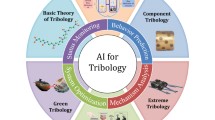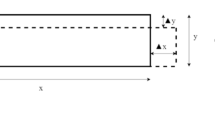Abstract
In order to ensure the mechanical performance and machining accuracy of the machine tool, the problem of mutual deviations of the machine tool moving parts in the machining process, which causes machining errors and subsequent accuracy prediction difficulties, is solved. Firstly, the structure and motion mechanism of the machine tool are analysed; a static accuracy model of the machine tool machining posture relationship is established using multi-body system theory and coordinate transformation; the measured deviation values are fitted and solved according to the formula; and the geometric error law affecting machining accuracy and the distribution of machining point error values in the machine tool motion space are explored. Then, the response surface method is used to simplify the solution. Finally, the blade is selected as the machined part, and the machining trajectory is extracted for experiments to obtain the error distribution range of the machining surface of the blade. The final experimental results surface, along the Z-directional component, and the integrated average compensation rate reached 42.6% and 89.6%, respectively, verifying the effectiveness of the method in this paper.



























Similar content being viewed by others
Data availability
The datasets used or analysed during the current study are available from the corresponding author on reasonable request.
Code availability
The codes used or analysed during the current study are available from the corresponding author on reasonable request.
References
Wang Y, Wang D, Zhang S, Tang Z, Wang L, Liu Y (2021) Design and development of a five-axis machine tool with high accuracy, stiffness and efficiency for aero-engine casing manufacturing. Chin J Aeronautics 35:485 (ISSN 1000-9361)
Ji Q, Li C, Zhu D, ** Y, Lv Y, He J (2020) Structural design optimization of moving component in CNC machine tool for energy saving. J Cleaner Prod 246:118976 (ISSN 0959-6526)
Ibaraki S, Okumura R (2021) A machining test to evaluate thermal influence on the kinematics of a five-axis machine tool. Int J Mach Tools Manufact 163:103702 (ISSN 0890-6955)
Lai Y, Liao C, Chao Z (2018) Inverse kinematics for a novel hybrid parallel–serial five-axis machine tool. Robotics Comput-Integr Manufact 50:63–79 (ISSN 0736-5845)
Liu Y, Zhang H, Wang X (2017) Analysis on influence of perpendicularity error of five axis NC machine tool error modeling accuracy and complexity. Procedia Eng 174:557
Ding S, Huang X, Yu C, Wang W (2016) Actual inverse kinematics for position-independent and position-dependent geometric error compensation of five-axis machine tools. Int J Mach Tools Manufact 111:55–62 (ISSN 0890-6955)
Tao H, Chen R, Xuan J, **a Q, Yang Z, Zhang X, He S, Shi T (2020) Prioritization analysis and compensation of geometric errors for ultra-precision lathe based on the random forest methodology. Precision Eng 61:23
Yang B, Zhang G, Ran Y, Yu H (2019) Kinematic modeling and machining precision analysis of multi-axis CNC machine tools based on screw theory. Mech Mach Theory 140:538–552
Liu Y, Ding F, Li D, Wu Y, Xue J, Wang W, Qiao Z, Wang B (2020) Machining accuracy improvement for a dual-spindle ultra-precision drum roll lathe based on geometric error analysis and calibration. Precis Eng 66:401–416
Huang Y, Fan K, Lou Z, Sun W (2020) A novel modeling of volumetric errors of three-axis machine tools based on Abbe and Bryan principles. Int J Mach Tools Manufact 151:103527
Maeng S, Min S (2020) Simultaneous geometric error identification of rotary axis and tool setting in an ultra-precision 5-axis machine tool using on-machine measurement. Precision Eng 63:94
Fan J, Tao H, Pan R, Chen D (2020) An approach for accuracy enhancement of five-axis machine tools based on quantitative interval sensitivity analysis. Mech Mach Theor 148:103806
Wu H, Zheng H, Li X, Wang W, **ang X, Meng X (2020) A geometric accuracy analysis and tolerance robust design approach for a vertical machining center based on the reliability theory. Measurement 161:1070809
Liu Y, Zhang H, Wang X (2017) Analysis on influence of perpendicularity error of five axis NC machine tool error modeling accuracy and complexity. Procedia Engineering 174:557–565
Gu J, Agapiou J, Kurgin S (2017) Error compensation and accuracy improvements in 5-axis machine tools using the global offset method, Journal of Manufacturing Systems, Volume 44. Part 2:324–331
Shneor Y, Chapsky V, Shapiro A (2018) Virtual verification of 5-axis machine tools based on workpiece accuracy analysis: software tool instead of expensive machining tests. Procedia Manufact 21:228–235
Jiang X, Wang L, Liu C (2019) Geometric accuracy evaluation during coordinated motion of rotary axes of a five-axis machine tool. Measurement 146:403
Fan J, Tao H, Pan R, Chen D (2020) An approach for accuracy enhancement of five-axis machine tools based on quantitative interval sensitivity analysis. Mech Mach Theory 148:103806
Wang Y, Wang D, Zhang S, Tang Z, Wang L, Liu Y (2021) Design and development of a five-axis machine tool with high accuracy, stiffness and efficiency for aero-engine casing manufacturing. Chin J Aeronautics 35:485
Liang R, Wang Z, Chen W, Ye W (2021) Accuracy improvement for RLLLR five-axis machine tools: a posture and position compensation method for geometric errors. J Manuf Process 71:724–733
Aguado S, Santolaria J, Aguilar J, Samper D, Velazquez J (2015) Improving the accuracy of a machine tool with three linear axes using a laser tracker as measurement system. Procedia Eng 132:756–763
Cai L, Zhang Z, Cheng Q, Liu Z, Gu P, Qi Y (2016) An approach to optimize the machining accuracy retainability of multi-axis NC machine tool based on robust design. Precis Eng 43:370–386
Zhang Y, Xu R, Li X (2020) Cheng X, Zheng G, Meng J, A tool path generation method based on smooth machine rotary angle and tilt angle in five-axis surface machining with torus cutters. Int J Adv Manuf Technol 107:4261–4271
Zhong L, Bi Q, Huang N, Wang Y (2018) Dynamic accuracy evaluation for five-axis machine tools using S trajectory deviation based on R-test measurement. Int J Mach Tools Manuf 125:20–33
Yang S, Lee K (2021) Machine tool analyzer: a device for identifying 13 position-independent geometric errors for five-axis machine tools. Int J Adv Manuf Technol 115:2945–2957
Liu Y, Altintas Y (2022) Predicting the position-dependent dynamics of machine tools using progressive network. Precision Engi 73:409–422
Theissen N, Laspas T, Szipka K, Archenti A (2018) Virtual machining system simulator: analysis of machine tool accuracy. Procedia Manufact 25:338–343
Lu Z, Yang X, Zhao J (2022) Tool-path planning method for kinematics optimization of blade machining on five-axis machine tool. Int J Adv Manuf Technol 121:1253–1267
Wu C, Fan J, Wang Q, Chen D (2018) Machining accuracy improvement of non-orthogonal five-axis machine tools by a new iterative compensation methodology based on the relative motion constraint equation. Int J Mach Tools Manuf 124:80–98
Groos L, Held C, Keller F, Wendt K, Franke M, Gerwien N (2020) Map** and compensation of geometric errors of a machine tool at different constant ambient temperatures. Precis Eng 63:10–17
Funding
This study was supported by High-tech Key Research and Development Projects from Science and Technology Department of Sichuan Province, Grant No. 2021YFG0056 and funded by Intelligent Policing Key Laboratory of Sichuan Province, No. ZNJW2022KFQN004 and ZNJW2022ZZMS003.
Author information
Authors and Affiliations
Corresponding author
Ethics declarations
Ethics approval
This project is about China’s machine tool precision system. This project is taken from the five-axis vertical machining centre as the main research point. In this project, in order to ensure that these regulations are effectively implemented, the school’s academic ethics committee has to play a strict supervisory role and guarantee its behaviour.
Consent to participate
Agree to participate in this project.
Consent to publication
This project agrees to publish the journal.
Competing interests
The authors declare no competing interests.
Additional information
Publisher's note
Springer Nature remains neutral with regard to jurisdictional claims in published maps and institutional affiliations.
The work described is original. It has not been published in whole or in part, nor has it been submitted elsewhere for publication elsewhere. All authors have seen the manuscript and approved to submit to your journal.
Appendix
Appendix
The additional equation is as follows:
Rights and permissions
Springer Nature or its licensor (e.g. a society or other partner) holds exclusive rights to this article under a publishing agreement with the author(s) or other rightsholder(s); author self-archiving of the accepted manuscript version of this article is solely governed by the terms of such publishing agreement and applicable law.
About this article
Cite this article
Zhou, T., Yinghua, L., Jie, J. et al. A method of sensitivity analysis and precision prediction for geometric errors of five-axis machine tools based on multi-body system theory. Int J Adv Manuf Technol 123, 3497–3512 (2022). https://doi.org/10.1007/s00170-022-10495-7
Received:
Accepted:
Published:
Issue Date:
DOI: https://doi.org/10.1007/s00170-022-10495-7




